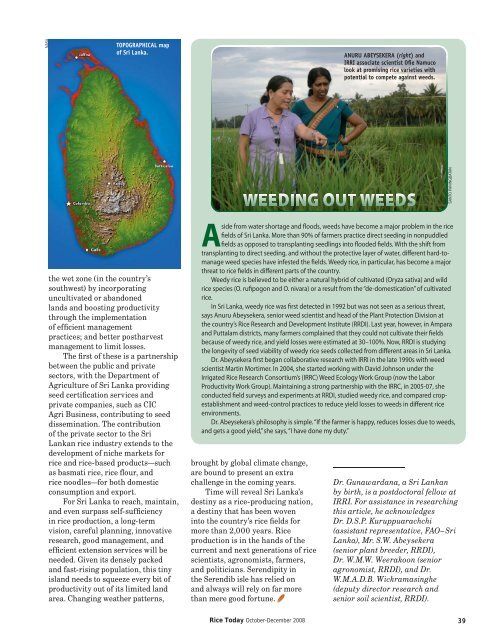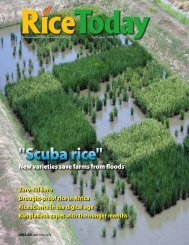Rice Today - adron.sr
Rice Today - adron.sr
Rice Today - adron.sr
Create successful ePaper yourself
Turn your PDF publications into a flip-book with our unique Google optimized e-Paper software.
NASATOPOGRAPHICAL mapof Sri Lanka.ANURU ABEYSEKERA (right) andIRRI associate scientist Ofie Namucolook at promising rice varieties withpotential to compete against weeds.SANTO PANINGBATANthe wet zone (in the country’ssouthwest) by incorporatinguncultivated or abandonedlands and boosting productivitythrough the implementationof efficient managementpractices; and better postharvestmanagement to limit losses.The first of these is a partnershipbetween the public and privatesectors, with the Department ofAgriculture of Sri Lanka providingseed certification services andprivate companies, such as CICAgri Business, contributing to seeddissemination. The contributionof the private sector to the SriLankan rice industry extends to thedevelopment of niche markets forrice and rice-based products—suchas basmati rice, rice flour, andrice noodles—for both domesticconsumption and export.For Sri Lanka to reach, maintain,and even surpass self-sufficiencyin rice production, a long-termvision, careful planning, innovativeresearch, good management, andefficient extension services will beneeded. Given its densely packedand fast-rising population, this tinyisland needs to squeeze every bit ofproductivity out of its limited landarea. Changing weather patterns,Aside from water shortage and floods, weeds have become a major problem in the ricefields of Sri Lanka. More than 90% of farmers practice direct seeding in nonpuddledfields as opposed to transplanting seedlings into flooded fields. With the shift fromtransplanting to direct seeding, and without the protective layer of water, different hard-tomanageweed species have infested the fields. Weedy rice, in particular, has become a majorthreat to rice fields in different parts of the country.Weedy rice is believed to be either a natural hybrid of cultivated (Oryza sativa) and wildrice species (O. rufipogon and O. nivara) or a result from the “de-domestication” of cultivatedrice.In Sri Lanka, weedy rice was first detected in 1992 but was not seen as a serious threat,says Anuru Abeysekera, senior weed scientist and head of the Plant Protection Division atthe country’s <strong>Rice</strong> Research and Development Institute (RRDI). Last year, however, in Amparaand Puttalam districts, many farmers complained that they could not cultivate their fieldsbecause of weedy rice, and yield losses were estimated at 30–100%. Now, RRDI is studyingthe longevity of seed viability of weedy rice seeds collected from different areas in Sri Lanka.Dr. Abeysekera first began collaborative research with IRRI in the late 1990s with weedscientist Martin Mortimer. In 2004, she started working with David Johnson under theIrrigated <strong>Rice</strong> Research Consortium’s (IRRC) Weed Ecology Work Group (now the LaborProductivity Work Group). Maintaining a strong partnership with the IRRC, in 2005-07, sheconducted field surveys and experiments at RRDI, studied weedy rice, and compared cropestablishmentand weed-control practices to reduce yield losses to weeds in different riceenvironments.Dr. Abeysekera’s philosophy is simple. “If the farmer is happy, reduces losses due to weeds,and gets a good yield,” she says, “I have done my duty.”brought by global climate change,are bound to present an extrachallenge in the coming years.Time will reveal Sri Lanka’sdestiny as a rice-producing nation,a destiny that has been woveninto the country’s rice fields formore than 2,000 years. <strong>Rice</strong>production is in the hands of thecurrent and next generations of ricescientists, agronomists, farmers,and politicians. Serendipity inthe Serendib isle has relied onand always will rely on far morethan mere good fortune.Dr. Gunawardana, a Sri Lankanby birth, is a postdoctoral fellow atIRRI. For assistance in researchingthis article, he acknowledgesDr. D.S.P. Kuruppuarachchi(assistant representative, FAO–SriLanka), Mr. S.W. Abeysekera(senior plant breeder, RRDI),Dr. W.M.W. Weerakoon (senioragronomist, RRDI), and Dr.W.M.A.D.B. Wickramasinghe(deputy director research andsenior soil scientist, RRDI).<strong>Rice</strong> <strong>Today</strong> October-December 200839RT7-4 (p24-44)_FA.indd 3910/9/2008 8:28:38 AM
















